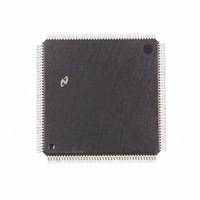DP83934CVUL-25 National Semiconductor, DP83934CVUL-25 Datasheet - Page 24

DP83934CVUL-25
Manufacturer Part Number
DP83934CVUL-25
Description
IC CTRLR ORIENT NETWORK 160PQFP
Manufacturer
National Semiconductor
Datasheet
1.DP83934AVQB.pdf
(104 pages)
Specifications of DP83934CVUL-25
Controller Type
Network Interface Controller (NIC)
Interface
Twisted Pair
Voltage - Supply
4.75 V ~ 5.25 V
Current - Supply
140mA
Operating Temperature
0°C ~ 70°C
Mounting Type
Surface Mount
Package / Case
160-MQFP, 160-PQFP
Lead Free Status / RoHS Status
Contains lead / RoHS non-compliant
Other names
*DP83934CVUL-25
Available stocks
Company
Part Number
Manufacturer
Quantity
Price
Company:
Part Number:
DP83934CVUL-25
Manufacturer:
Texas Instruments
Quantity:
10 000
Part Number:
DP83934CVUL-25
Manufacturer:
NS/国半
Quantity:
20 000
5 0 Buffer Management
5 1 BUFFER MANAGEMENT OVERVIEW
The SONIC-T’s buffer management scheme is based on
separate buffers and descriptors ( Figures 5-3 and 5-12 )
Packets that are received or transmitted are placed in buff-
ers called the Receive Buffer Area (RBA) and the Transmit
Buffer Area (TBA) The system keeps track of packets in
these buffers using the information in the Receive Descrip-
tor Area (RDA) and the Transmit Descriptor Area (TDA) A
single (TDA) points to a single TBA but multiple RDAs can
point to a single RBA (one RDA per packet in the buffer)
The Receive Resource Area (RRA) which is another form
of descriptor is used to keep track of the actual buffer
When packets are transmitted the system sets up the pack-
ets in one or more TBAs with a TDA pointing to each TBA
There can only be one packet per TBA TDA pair A single
TBA however may be made up of several fragments of
data dispersed in memory There is one TDA pointing to
each TBA which specifies information about the buffer’s
size location in memory number of fragments and status
after transmission The TDAs are linked together in a linked
list The system causes the SONIC-T to transmit the pack-
ets by passing the first TDA to the SONIC-T and issuing the
transmit command
Before a packet can be received an RDA and RBA must be
set up by the system RDAs are made up as a linked list
similar to TDAs An RDA is not linked to a particular RBA
though Instead an RDA is linked specifically to a packet
after it has been buffered into an RBA More than one pack-
et can be buffered into the same RBA but each packet gets
its own RDA A received packet can not be scattered into
fragments The system only needs to tell the SONIC-T
where the first RDA and where the RDAs are Since an RDA
never specifically points to an RBA the RRA is used to
keep track of the RBAs The RRA is a circular queue of
pointers and buffer sizes (not a linked list) When the
SONIC-T receives a packet it is buffered into an RBA and a
unique corresponding RDA is written to so that it points to
and describes the new packet If the RBA does not have
enough space to buffer the next packet a new RBA is ob-
tained from the RRA
5 2 DESCRIPTOR AREAS
Descriptors are the basis of the buffer management scheme
used by the SONIC-T An RDA points to a received packet
within an RBA an RRA points to an RBA and a TDA points
to a TBA which contains a packet to be transmitted The
conventions and registers used to describe these descrip-
tors are discussed in the next three sections
5 2 1 Naming Convention for Descriptors
The fields which make up the descriptors are named in a
consistent manner to assist in remembering the usage of
each descriptor Each descriptor name consists of three
components in the following format
The first two capital letters indicate whether the descriptor is
used for transmission (TX) or reception (RX) and is then
followed by the descriptor name having one of two names
RX TX descriptor name field
24
Figure 5-2 shows an example of the Transmit Descriptor
rsrc
pkt
The last component consists of a field name to distinguish it
from the other fields of a descriptor The field name is sepa-
rated from the descriptor name by a period (‘‘ ’’) An exam-
ple of a descriptor is shown in Figure 5-1
5 2 2 Abbreviations
Abbreviations are used to describe the SONIC-T registers
and data structures in memory The ‘‘0’’ and ‘‘1’’ in the ab-
breviations indicate the least and most significant portions
of the registers or descriptors Table 5-1 lists the naming
convention abbreviations for descriptors
5 2 3 Buffer Management Base Addresses
The SONIC-T uses three areas in memory to store descrip-
tor information the Transmit Descriptor Area (TDA) the Re-
ceive Descriptor Area (RDA) and the Receive Resource
Area (RRA) The SONIC-T accesses these areas by concat-
enating a 16-bit base address register with a 16-bit offset
register The base address register supplies a fixed upper
16 bits of address and the offset registers provide the lower
16 bits of address The base address registers are the Up-
per Transmit Descriptor Address (UTDA) Upper Receive
Descriptor Address (URDA) and the Upper Receive Re-
source Address (URRA) registers The corresponding offset
registers are shown below
Table 5-1 defines the register mnemonics
Area and the Receive Descriptor Area being located by the
UTDA and URDA registers The descriptor areas RDA
TDA and RRA are allowed to have the same base address
i e URRA
to prevent these areas from overwriting each other
Upper Address Registers
e
e
FIGURE 5-1 Receive Buffer Descriptor Example
Resource descriptor
Packet descriptor
e
URDA
URRA
URDA
UTDA
e
UTDA Care however must be taken
RSA REA RWP RRP
Offset Registers
CRDA
CTDA
TL F 11719 – 96











